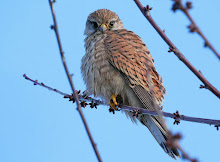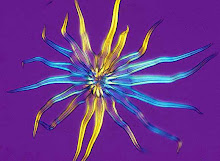After a summer drought, followed by a mild and wet September and early October, it's turning out to be a very good autumn for fungal forays.
Here are a few toadstools that I've encountered recently. I struggle a bit with identifying fungi and sometimes find that field guides are confusing, not least because most only show toadstools at the peak perfection of their development, so any found that are in early or late stages of growth or decay are harder to name with real confidence.
A birch bolete Leccinum scabrum, always associated
with birch trees. An aging specimen in Durham University Botanic Garden, at the point where its convex cap begins
to soften, flatten and then become concave.
An easy one - sulphur tuft Hypholoma
fasciculare on a dead tree stump in Durham University Botanic Garden.
A perfect cluster of what I think are shaggy parasols Chlorophyllum (Macrolepiota) rhacodes in Durham University Botanic Garden. They’ll
get taller, and their caps flatter, as they mature.
The true parasol mushroom is edible, said to be excellent,
but apparently shaggy parasols can cause stomach upsets in some people. There’s
a surprising number of smaller parasol-related species, collectively known as
dapperlings, of variable edibility, including one - Lepiota
brunneo-incarnata that’s deadly poisonous and contains the same toxin as
death cap so, as with all toadstool eating, accurate identification is
essential.

A sepia bolete Boletus
porosporus has risen through last autumn’s dead beach leaves. under the
hedge in my own garden. Isn’t that crazy-paving pattern of cracks on the cap wonderful? It’s one
of the less common Boletus species and this is the first time I’ve
seen it in the garden. Every year more toadstools appear here, perhaps
because I rake all the autumn leaves into the beds and borders, where they
decay and add humus to the soil, just as they do in woodland.
Found growing under an old yew in St. Brandon's churchyard, Brancepeth. I don't know what this beauty is and need to go back for a second look when the cap has expanded. There's a ring around the stipe and I suspect it's a species of agaric or maybe one of the parasols.I think these may be young puffballs, possibly Lycoperdon perlatum, but I need to go back for another look when they've matured a bit. They are growing through a layer of stone chips surrounding a memorial.Parasol Macrolepiota procera or more likely P. konradii in the grounds of the Bowes museum in Barnard Castle.
An older specimen of parasol Macrolepiota procera or P. konradii in the grounds of the Bowes museum in Barnard Castle. The chunky scales on the cap (see previous image) have flattened out as the cap expanded - the appearance of many toadstools changes as they age.
The very common lumpy bracket Trametes gibbosa on a decaying tree stump in the grounds of the Bowes museum, Barnard Castle. A long-lived bracket, often discoloured by a layer of green algae as it ages.
I think these may be shaggy scalycaps Pholiota squarrosa and common inkcaps Coprinopsis atramentaria sharing a decaying tree stump in the grounds of the Bowes museum, Barnard Castle.
Common inkcaps Coprinus comatus with their caps in the final stages of autodigestion, in the grounds of the Bowes museum, Barnard Castle. In another couple of days the only evidence of their existences will be an inky stain on the ground, loaded with spores.

I suspect these small brown toadstools (above and below), growing in a recently mown grassy woodland ride at the Woodland Trust's Low Burnhall reserve, could be brown mottlegills aka mower's mushroom Paneolina foenisecii, a common species in mown grass, but there are many small brown toadstools that resemble these and I'm unsure about that ID. The second image, below, shows how the cap becomes flattened and wavy-edged as it matures.
I think all of these toadstools in these last four images are honey fungus Armillaria mellea, a very variable species. Those in the first three pictures were probably growing on the surface roots of a dead larch, which it had most likely killed. The final image, with full expanded caps with wavy edges that have become concave as they've matured, shows a much older cluster on the stump of a dead alder. All at Durham Wildlife Trust's Low Barns Nature Reserve.




.jpg)
.jpg)
.jpg)



















.jpg)
.jpg)















































